Cather, Carhenge and Sandoz of the Sand Hills
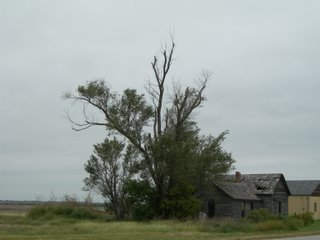
Having now spent seven days in Nebraska, it has become more difficult to characterize what Nebraska really is. This is a huge state with great variations in landscape and atmosphere. For Willa Cather, it became the storehouse and font for her creative energy. Her attachment to the place and the deep impression that the first year living in untamed wilderness nestled in the earth became the source of her truth and her art. She came back again and again to Red Cloud and the country that surrounded it and just as Jim Burden discovers at the end of My Antonia when he wanders away from the Black Hawk (Red Cloud) out into the prairie “ I had the sense of coming home to myself, and of having found out what a little circle man’s experience is. (p.371)
I had hurried to make it to Red Cloud on the first day to take in a special cowboy poet performance at the Opera House. R.P. Smith, who runs a ranch in Custer Co., Nebraska was an entertainer, who shared much about the rural life of his family and the challenges of working with horses and cows and the unpredictable actions of Mother Nature. Cowboy poetry is quite popular in the West with its even rhyme and old fashion values and its humor. Much of the presentation was like a stand-up comedy routine. He described in his folksy style, reminiscent of Will Rogers or Edgar A. Guest, the thorny process of introducing a Japanese foreign exchange student to the hazards of herding cattle, the security nightmare of taking a group of teenagers to Washington, D.C., and the joys of working with horses, who often have a mind of their own. I found the show earnest, funny, and not as maudlin as I had expected. I liked the honesty and sincerity and the way that the poetry reflected the real life experience of the fast diminishing number of people who inhabit the rural West. Here’s a sample:
To the Participant
Here’s to the pickers and singers
you’ll never see on CMT;
To the undiscovered poets
who read their prose for free;
To the roper whose loop comes back empty;
…the barrel racer whose horse don’t bend;
To the roughstock man who is dismounted
before the whistle signals his ride’s end;
To all the folks who keep on tryin’,
though their efforts seem for naught-
They get back up, brush off the dust,
and give it all they’ve got.
The saddest song in all the world
is the one that goes unsung.
So, here’s to life’s participants
who do their thing for fun-
And if your talents never raise you
far above the rest-
Well all that really matters friend,
is that you give your best!
(From A Ride Through Rhyme by R.P. Smith p.25)
I had arranged to tour the seven buildings that the Willa Cather Foundation now owns. I was lucky enough to have a very knowledgeable and enthusiastic guide who had lived in Red Cloud most of her life and had raised her family there. In the Cather House,it was amazing to see the attic bedroom with the original wall paper that Willa had chosen and applied. The
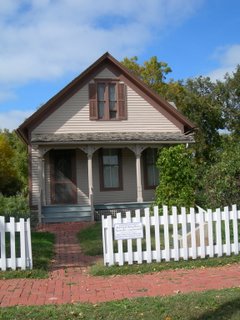 house was a good size but had to serve the needs of 11 people- Mr. and Mrs. Cather, Mrs. Cather’s mother ( Rachel Boak), the hired girl who had come with them from Virginia, and the seven children, the four who migrated and three that were born in Nebraska. It would have been quite snug. The attic rooms were not insulated, and there were obvious
house was a good size but had to serve the needs of 11 people- Mr. and Mrs. Cather, Mrs. Cather’s mother ( Rachel Boak), the hired girl who had come with them from Virginia, and the seven children, the four who migrated and three that were born in Nebraska. It would have been quite snug. The attic rooms were not insulated, and there were obvious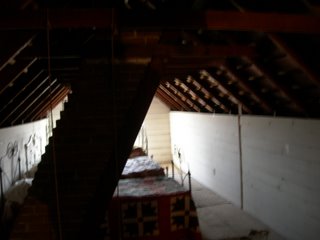 cracks where snow and wind could penetrate. Our modern temperature control demands would have been laughable in this house. All of the buildings were important in one or more of Willa’s books- the depot, the Miner House, the Opera House, the Catholic Church, the Episcopal Church, and The Farmer’s and Merchants’ Bank. When I mentioned that I had seen many small towns that seemed to be shrinking, my guide said that Red Cloud was half as big as it
cracks where snow and wind could penetrate. Our modern temperature control demands would have been laughable in this house. All of the buildings were important in one or more of Willa’s books- the depot, the Miner House, the Opera House, the Catholic Church, the Episcopal Church, and The Farmer’s and Merchants’ Bank. When I mentioned that I had seen many small towns that seemed to be shrinking, my guide said that Red Cloud was half as big as it 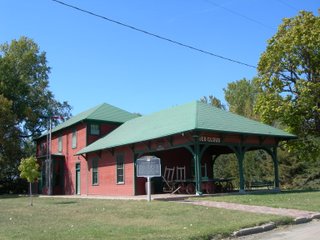 as in the middle of the last century. She credited the Willa Cather Heritage for much of the success of keeping Red Cloud stable and thriving. Most small farming town are drying up as farms get bigger and services are centralized. Children don’t stay. They are attracted to the opportunities and lifestyle of the cities. Red Cloud has a Subway Restaurant but no McDonalds. You can be happy now knowing that Middleburg is not the only small town in America without a MickyD’s.
as in the middle of the last century. She credited the Willa Cather Heritage for much of the success of keeping Red Cloud stable and thriving. Most small farming town are drying up as farms get bigger and services are centralized. Children don’t stay. They are attracted to the opportunities and lifestyle of the cities. Red Cloud has a Subway Restaurant but no McDonalds. You can be happy now knowing that Middleburg is not the only small town in America without a MickyD’s.
As one moves north and west in Nebraska, the landscape becomes more sweeping and the towns and other signs of civilization become more and more scarce. However, in Alliance, Nebraska, I was able to visit a unique American artistic take on that historic and cultural icon- Stonehenge. Nebraska’s answer is – Carhenge. Designed and constructed by artist, Jim Reinders in memory of his father who farmed this land, this striking formation with the sand hills in the distance copies the original size and placement of Stonehenge (96 ft. in diameter) with 38 American cars, all painted gray. The heel stone is a 1962 Cadillac. Carhenge was dedicated on the Summer Solstice, 1987. It is truly one of a kind.
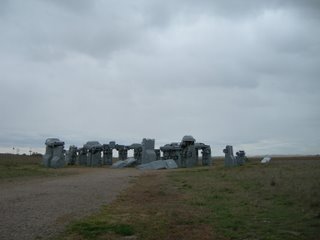
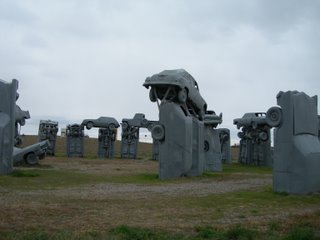
Another one of a kind was Mari Sandoz. Born deep in the Sand Hills to a father who thought writers were akin to maggots, she overcame this but never felt loved by this father who did not spare the rod or the criticism and her mother who worked hard but had little time left to do anything but assign her more chores to do. The Sand Hills are lonely and often grey, with wind and great extremes of weather. Mari loved to write and when she won a contest at the age of twelve, her father, Jules, beat her for her foolish endeavor. She soon escaped life on the Niobrara River and her father by passing the rural teachers exam at the age of 16. She left the Sand Hills finally in 1919 after a short, disastrous marriage to a neighboring rancher and escaped to Lincoln where she could work on her writing. It was an amazing irony, that her first successful book, published in 1935, was Old Jules, the story of her father’s life and his struggles as a new settler in the Niobrara Valley. A review described this book as being “written with barbed wire on sandpaper." More later...
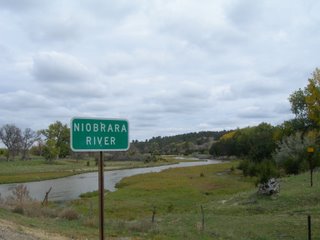

2 Comments:
I think it says alot about place. Alliance is west of the Sand Hils in very flat high plains land that is irrigated and farmed extensively. It puts one in mind of the Salisbury Plain where Stonehenge rests. In Britain,the spiritual and historical heft of Stonehenge is palpable. It emerges into view, and you are taken aback and back through time immediately. With Carhenge- the land is so vast that surrounds it that it is dwarfed. Fitting, it seems. It is the bold idea of one man who loved the original and cars. Americans are all about youth and the new. We alternately worship and laugh at our past, sweeping away what doesn't fit our needs and "modernizing" anything that suits us. Carhenge is more like Wall Drug or the Corn Palace, a gimmick, a sort of "sideshow" to attract the curiosity seekers- very American. The summer solstice and the Druids are strangers here. Since they have added a few other metal scuptures on the periphery, it's almost as if it isn't enough to just have carcrafted Stonehenge- more is needed. Perhaps, this is the perfect evocation of time and place. Our autos, butts and hoods in the air creating a pseudo ancient monument to our mobile culture. In the end, I love the idea of Carhenge and the effect. Maybe the whole idea of monoliths and monuments is passe in this "Wikiality" age. It only means in the end what we think it means, and meanwhile, it gives Alliance a new hook or beacon to lure traveler to go a little off their Interstate 80 path and maybe drop some change while they're catching a glimpse of American folk art or perhaps a new American spritual mecca in the making.
Working online seems to invite spelling and grammar mistakes. I think it is the quick informality of the medium. Words that I would never spell wrong in another venue come up that way. It is all couched in language that has not been coifed but is valued for its still papable "body heat." The immediacy seems to trump rules. What we always stress about My Space, etc. that it seems like a personal warm and fuzzy diary or journal but BEWARE!- the whole world can read it is certainly at play here. The intriguing development in all of this is the collaborative nature that is its essence. We all become responsible for the ultimate quality of the thoughts and words. We are co-crafters. If it makes us more able to laugh at and learn from our mistakes and value the collective "journey" then much has been accomplished. I appreciate your thoughts, and I agree about "our" history. I have always loved American History and have suffered the same sort of chiding from those who have a more substantial panorama to survey. One of my past advisees, Kanita Kunaputarawong from Thailand, gave me a beautiful book about Thai history with a comment about fitting the heft of thousands of years into a year long course. She was so right- what a chalenge! I see an analogy in that I have experienced so much in my westward journey that it's like digesting the whole continent- beautiful, complex, overwhelming, and spiritually illuminating in its powerful sweep and the inveterate sense of longing that defines each community, thriving or dying, all along the way.
Post a Comment
<< Home